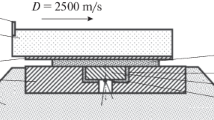A method for assessing the powder explosibility was developed using analysis of dispersed powder distribution in reaction vessels, combustion propagation, and comparative tests of atomizers. Dependences of the maximum explosion pressure on the concentration of dispersed particles and oxygen content in mixtures with nitrogen and other inert gases determined with a 4-L experimental facility of the Frantsevich Institute for Problems of Materials Science (IPM) were examined. The experimental data were used to study the effect of reaction vessel sizes on the maximum explosion pressure and maximum rate of explosion pressure rise. The applicability of the cube root law for geometrically similar vessels, the similarity criteria for dispersed gas flows (including the homochronism criterion for turbulent flows) being obeyed, was shown. The metal powders were categorized in accordance with the modified explosion index based on combustibility and explosibility characteristics and calculated in relative units with regard to the explosion hazard of silicon powders. The irregular gas distribution substantially affected the accuracy of the explosion characteristics. In compliance with the IPM method, the explosion characteristics are corrected by the concentration factor, characterizing the dispersed powder distribution in the reaction vessel. Incomplete disintegration of powder particle aggregates by a mushroom-shaped atomizer and their incomplete combustion (apparatus of the United States Bureau of Mines) led to underestimation of the maximum explosion pressure and overestimation of the lower concentration ignition limit, while the dispersed powder concentration was calculated as the ratio between the dispersed powder weight and vessel volume.











Similar content being viewed by others
References
G.I. Vasilieva, V.G. Tokhtuev, and O.D. Neikov, “Evaluation of the explosion hazard of powders by the maximum explosion pressure and maximum rate of explosion pressure rise. I. Explosion propagation in gas suspensions,” Powder Metall. Met. Ceram., 60, No. 9–10, 635–642 (2021).
H.G. Dorsett, M. Jacobson, J. Nagy, and R. Williams, Laboratory Equipment and Test Procedures for Evaluating Explosibility of Dusts. Report Inv. 5624, US Bureau of Mines, Washington DC, USA (1960).
R.K. Eckhoff, Dust Explosions in the Process Industries, 3rd ed., Gulf Professional Publ., Amsterdam (2003).
R. Siwek, “Reliable determination of safety characteristics in 20 liter apparatus,” in: Proc. Conf. Flammable Dust Explosions, St. Louis, MO, USA (1988), pp. 1–2.
“ASTM Standard E 1226–88 for pressure and rate of pressure rise for combustible dust,” in: Annual Book of ASTM Standards, American Society for Testing and Materials (ASTM), Philadelphia (1988), Vol. 14.02, pp. 688–698.
GOST 12.1.044–2018, Occupational Safety Standards, Fire and Explosion Hazard of Substances and Materials. Listing of Indices and Methods for Their Determination [in Russian], Standartinform, Moscow (2018), p. 196.
V.V. Nedin, O.D. Neikov, A.G. Alekseev, and V.A. Krivtsov, Explosion Hazard of Metal Powders [in Russian], Naukova Dumka, Kyiv (1971).
A.G. Alekseev and O.D. Neikov, “The explosion risk of metal powders,” Staub-Reinhalt. Luft, 50, 245–250 (1990).
International Standard ISO/DIS 6184/1, International Standards Organization, Explosion Protection Systems. Part 1: Determination of Explosion Indices of Combustible Dusts in Air, ISO, Geneva (1985).
A.G. Alekseev, E.S. Kostina, and V.V. Nedin, “Effect of the system size on explosion parameters of titanium powder suspended in air,” in: Prevention of Sudden Ignitions of Powders and Explosive Gas Systems [in Russian], Naukova Dumka, Kyiv (1975), pp. 18–28.
J.E. Nagy, C. Seiler, J.W. Conn, and H.S. Verakis, Explosion Development in Closed Vessels. Report Inv. 7507, US Bureau of Mines, Washington DC, USA (1971), p. 50.
A.G. Alekseev and E.S. Kostina, “Determining the explosion safety of oxygen content in the protective atmosphere for dispersed titanium powders,” in: Prevention of Sudden Explosions of Dispersed Gas Systems [in Russian], Naukova Dumka, Kyiv (1971), pp. 78–85.
A.G. Alekseev, A.F. Shapoval, V.V. Dikov, B.S. Limonov, and B.R. Osipov, “Study of combustibility and explosibility characteristics of aluminum and magnesium powders and some alloys produced from them,” in: Prevention of Sudden Explosions of Atomized Gas Systems [in Russian], Naukova Dumka, Kyiv (1975), pp. 106–109.
I. Hartmann, “Recent research on the explosibility of dust dispersions,” Ind. Eng. Chem., 40, 752–758 (1948).
D.R. Ballal, “Ignition and flame quenching of quiescent dust clouds of solid fuels,” Proc. R. Soc. London, A369, 479–500 (1980).
R.K. Eckhoff, S.J. Parker, B. Gruvin, M. Hatcher, and T. Johansson, “Ignitability and explosibility of silicon dust clouds,” J. Electrochem. Soc., 133, 2631–2637 (1986).
Guide to Legislation and 'Health and Safety' in the European PM Industry, Publ. EPMA (1997).
M. Jacobson, A.R. Cooper, and J. Nagy, Explosibility of Metal Powders. Report Inv. 6516, US Bureau of Mines, Washington (1964), p. 31.
A.N. Baratov, A.Ya. Korolchenko, and G.N. Kravchuk, Fire and Explosion Hazards of Substances and Materials and Firefighting Agents: Handbook [in Russian], in 2 books, Khimiya, Moscow (1990), p. 496.
V.G. Gopienko, S.Yu. Petrovich, V.P. Cherepanov, A.K. Yarmolovich, A.Yu. Baimakov, I.B. Grishchenko, and V.A. Baranov, “Metal aluminum, magnesium, titanium, and silicon powders,” in: A.I. Rudski (ed.), Consumer Properties and Applications [in Russian], Izd. Politekh. Univ., Saint Petersburg (2012), p. 356.
O.D. Neikov, Yu.V. Milman, D.B. Miracle, D.V. Lotsko, A.I. Sirko, A.V. Sameljuk, and N.A. Yefimov, “Explosion-security of manufacture processes of advanced water atomized aluminium alloy P/M technology,” in: V. Arnold, C.L. Chu, W.F. Jandeska, and H.I. Sanderow, Proc. 2002 Powder Metallurgy World Congress, MPIF, Orlando, FL, USA (2002), pp. 760–769.
Author information
Authors and Affiliations
Corresponding author
Additional information
V.G. Tokhtuev is deceased
Translated from Poroshkova Metallurgiya, Vol. 60, Nos. 11–12 (542), pp. 138–159, 2021.
Rights and permissions
About this article
Cite this article
Vasilieva, G., Tokhtuev, V., Radchenko, O. et al. Evaluation of the Explosion Hazard of Powders by the Maximum Explosion Pressure and Maximum Rate of Explosion Pressure Rise II. Methods for Testing the Powder Explosion Characteristics. Powder Metall Met Ceram 60, 766–780 (2022). https://doi.org/10.1007/s11106-022-00287-9
Received:
Published:
Issue Date:
DOI: https://doi.org/10.1007/s11106-022-00287-9



